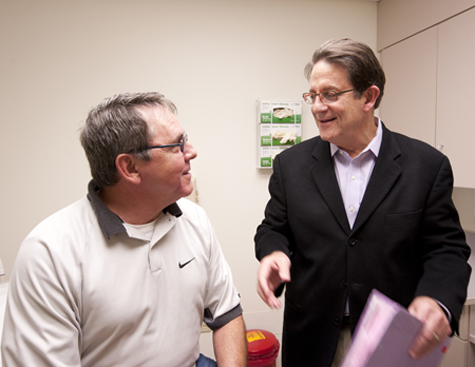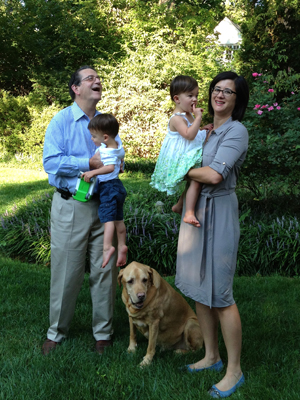
Every year, Siteman Cancer Center hosts a gathering for former bone marrow transplant patients, their families and the staff who helped care for them. It’s a celebration of survival. And every year, John F. DiPersio, MD, PhD, chief of the Division of Oncology at Washington University School of Medicine in St. Louis, looks out over the audience and marvels.
“It’s an incredible night for both the patients and the staff,” says DiPersio, the Virginia E. and Sam J. Golman Professor of Medicine. “Patients who may have felt like they were struggling alone in the world see hundreds of people sitting right beside them who are happy to be alive and doing well.”
The celebration is approaching its 20th year, and in 2011, the program announced its 5,000th bone marrow transplant. Looking back, DiPersio also marvels at the growth of the bone marrow transplant division since his arrival in 1994.
“When I came, we had five faculty,” he says. “Now we have 70 faculty and about 700 employees. We’ve built a great basic science group, and we’re very strong in genomics and patient care across the spectrum of cancer types. I think we’ve done well, and that makes me proud.”
Captivated by science, focused on medicine
DiPersio was born in Boston to an Irish mother and Italian father. They were the kind of parents who let him wear a Zorro costume on his first day of kindergarten. Raised in a nearby town called Scituate, he says he was captivated by space, physics and science in general and grew up wanting to be a pilot and an astronaut. But losing his left eye after a high school hockey injury prompted him to change career paths.
“In college, I focused more on medicine,” he says. “I liked the idea of taking care of very sick patients with complicated problems, and getting to know them over a long period of time. Today, that’s what I find most rewarding.”
DiPersio earned a bachelor’s degree in biology from Williams College and a combined medical degree and doctorate in microbiology from the University of Rochester. After an internship and residency at the University of Texas, Southwestern Medical Center in Dallas, and his first faculty position at the University of California, Los Angeles, he returned to the University of Rochester as the first director of their bone marrow transplant program.
Less than four years later, Washington University faculty, including Timothy Ley, MD, John Atkinson, MD, and the late Stanley Korsmeyer, MD, recruited him to lead the bone marrow transplant division here.
“I walked into a great place,” DiPersio says. “I’ve not only had great colleagues, but I’ve had the opportunity to help train lots of great fellows and faculty.”
Also, DiPersio points out, he met his wife, Allison King, MD, MPH assistant professor of pediatrics. They first met when she was doing a rotation in the adult bone marrow transplant unit at Barnes-Jewish Hospital. Sometime later, when DiPersio was prepared to cancel travel plans because he couldn’t find someone to take care of his dog, Max (and he refused to leave Max in a kennel), King volunteered to help.
“She looked after my dog a few more times and one day Max pulled me aside and said, ‘You better wake up man – don’t blow this,’” DiPersio says with a laugh. “He left me a little note with his paw print on it.”
DiPersio and King now have 2-year-old twins, Jack and Isabella.
Directing cellular traffic
Throughout his career, DiPersio has worked at the intersection of basic science, clinical research and patient care. While treating patients and participating in a large number of clinical trials, DiPersio has maintained a strong basic research lab. A major area of interest is controlling the trafficking of cells — stem cells, leukemia cells and immune cells — to different parts of the body.
DiPersio and his colleagues, including Michael Rettig, PhD, and Geoffrey Uy, MD, were instrumental in developing a drug called plerixafor that was approved by the U.S. Food and Drug Administration in 2008 to help treat multiple myeloma and non-Hodgkin’s lymphoma. Plerixafor is a small molecule that blocks both stem cells and leukemia cells from attaching to the bone marrow. In patients with leukemia, DiPersio and his team showed that the drug dislodges leukemia cells from the bone marrow’s protective environment. Once forced into the bloodstream, the cancerous cells become more vulnerable to chemotherapy.
And likewise in healthy donors, plerixafor causes stem cells to leave the bone marrow and enter the circulation, where they can be collected for transplant into a leukemia patient.
“We’re now testing plerixafor and similar new drugs in early clinical trials in healthy stem cell donors,” DiPersio says. “Without plerixafor, the current process takes about a week. With this drug and other rapid mobilizing agents that we are studying, you can give one dose and collect stem cells from the donor in a matter of minutes or hours.”
And in an effort to minimize a major complication of stem cell transplants, DiPersio and his colleagues, including JaeBok Choi, PhD, are also studying immune cell trafficking around the body. About half of leukemia patients who receive stem cells from a donor develop graft-versus-host disease, a condition where donor immune cells attack the patient’s own body.
These donor immune cells are highly effective at fighting the leukemia. But at times, they also attack the skin, liver and gut of transplant recipients. In the intestine, graft-versus-host disease can cause severe inflammation, diarrhea and infections caused by bacteria leaking into the blood. Such toxicity reduces the patient’s quality of life and in some cases can result in death.
DiPersio and his colleagues recently showed in mice that blocking a protein known as the interferon gamma receptor on the donor immune cells prevents the cells from traveling to critical organs like the intestines but still leaves them capable of killing leukemia cells.
“If you can change where these immune cells go instead of killing them, you get the benefit of the transplant without the life-threatening complications of graft-versus-host disease,” DiPersio says. “That’s the holy grail of transplantation.”
Commitment to patients

Whether clinical or basic science, the goal of all this research is to improve care for patients.
“It’s important for patients to know that you’re pulling for them,” DiPersio says. “When things don’t work out, the key is to learn how to take it hard, but not so hard that it’s incapacitating. You can’t let the tragedies — or the triumphs — of one patient affect how you deal with the next patient.”
In addition to the annual patient celebration, DiPersio keeps other hopeful reminders of why he does what he does. He points to a framed photograph in his office — a large group of people in a local restaurant smile at the camera.
“I had a patient that was taking an experimental drug,” he says. “Very few elderly patients survive the type of leukemia he had. It’s now seven years later; he’s still on the drug. And he bought this restaurant. So I take my whole lab there for lunch every once in a while. We take over the whole place.”